Stitch Era - creating embroidery with hot fix stones
Introduction
This beginner's tutorial for the Stitch Era embroidery software explains how to create embroidery designs that include hotfix stones.
- Tutorial home page
- Stitch Era embroidery software
- Learning goals
- Digitize a vector graphic into an embroidery plus hotfix stones
- Prerequisites
- Stitch Era - creating embroidery from vector images
- Stitch Era - creating hot fix designs
- Related pages
- Hotfix stone
- Materials
- You can reuse the pictures. In the wiki, click on picture to make it larger, then click again and save it.
- Quality and level
- This text should technical people get going with Stitch Era. I use it for an optional master degree course in educational technology.
- Last major update
- October 2017.
This tutorial will combine some concepts and procedures from two other other tutorials, i.e. Stitch Era - creating embroidery from vector images and Stitch Era - creating hot fix designs. We will go through two simple examples. In the first, embroidery dominates, in the second hotfix stones are more important.
Rocket Example
Let's create a little rocket with nice crystal windows. We can find one on OpenClipArt
- Download Rocket icon By pitr
- Make sure to get the SVG file, e.g. click on the picture and then save as.
Resize the rocket in Inkscape
Since the Rocket is fairly small we would like to make it bigger, i.e. make it fit into a 10cm by 10 embroidery hoop. According to our experience, scaling works better in a vector editing tool. However, as you shall see, the result won't be usable, but for a mysterious reasons, scaling the drawing before does something good.
- Open the Rocket in Inkscape
- Select all, ungroup
- Open the transform menu (CTRL-SHIFT-m or Menu Object -> Transform)
- Tick "scale proportionally"
- Enter 95mm or 40 mm if you prefer a smaller size. 9.5 x 9.5cm can be considered a fairly large embroidery for this type of drawing.
- Save the file as plain SVG.
Import the scaled SVG rocket to Stitch Era
- Define a hoop size. We suggest 10 x 10cm
Artwork tab -> Open Vector file. You now should see the rocket. As you can see, Stitch Era does not take into account scaling using viewports as Inkscape does.
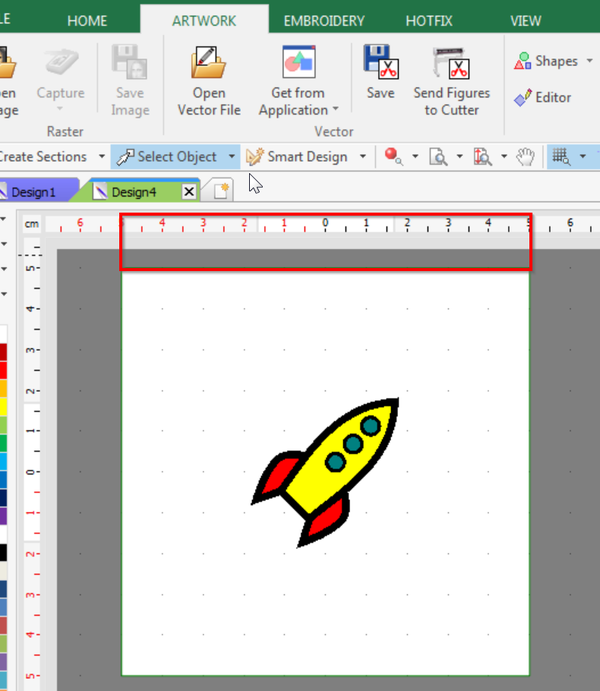
Adjust the size in Stitch Era
- Click on the rocket (do not use CTRL-A)
- Ungroup (using either the context menu or Artwork->Layout tab->Ungroup ALL)
- CTRL-A
- Artwork->Layout tab
- Set width to 90 (not 95, because we will need some extra space) or less, e.g. 40 if you want a small embroidery.
- Reposition in the middle (You can use the To Design tool in the ribbon bar, i.e. align horizontal and vertical with respect to the Design, i.e. the hoop).
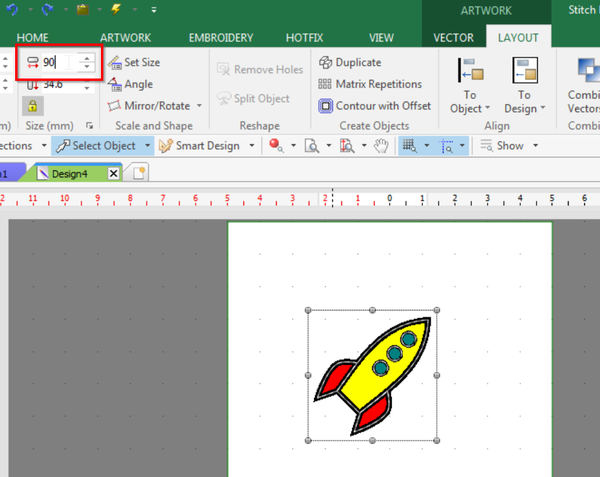
Save the file as, e.g. rocket-1.dsg
Adjust the size of the borders
The black borders of the parts (i.e. yellow body, blue windows and red fins= are too small for nice satin stitches. Let's make them just a bit bigger for now, i.e. 2mm.
- CTRL-A
- Vector Tab
- Set thickness of lines to 2mm as shown in the screenshot below.
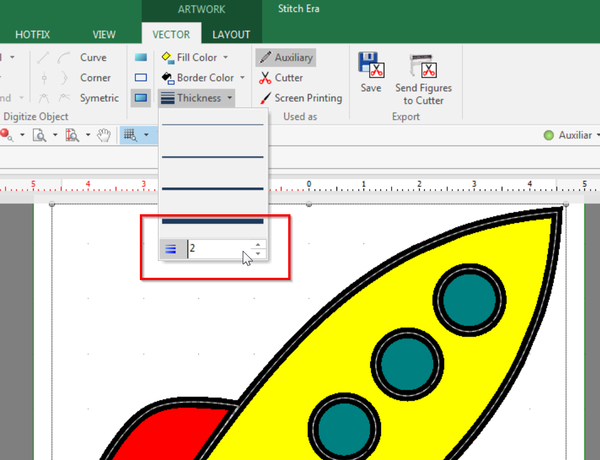
Save the file as, e.g. rocket-2.dsg
Flatten the drawing
This is not totally necessary for this rocket, since only the windows will overlap the yellow area. But make sure to recall this in case you work with another rocket. Most often vectors drawings use several shapes that are piled on top of each other. In embroidery, one normally uses single layers (plus a bit of underlay), otherwise the stitched design will get very stiff and can break needles, etc. Anyhow, in our case we also will "carve out" the windows from the yellow body.
- CTRL-A
- Layout Tab
- Combine vectors -> Simplify
After simplifying vectors you may have to add some overlap again in cas the test print shows that embroidery areas have some emptry space (e.g. tissue showing through) between sections. But that is a matter for more advanced users.
Digitize the rocket
Now let us translate the drawings to embroidery objects. Read the Stitch Era - creating embroidery from vector images tutorial first, if you don't understand the concept. Below we just outline the steps.
- CTRL-A
- Embroidery tab
- Art to stitch
- Select Art to stitch (intelligent)
- Select Objects to fill -> Fill Areas and Borderlines (we do want to keep the black borders)
- Select Artwork Unaltered (or process overlaps if you didn't simplify your geometry)
To verify the result, tick on Embroidery. If stitches are not yet generated, then hit F9 (or FN f9 on some computers) or the lightening icon on top. Verify if the black borders overlap with the yellow and red parts. In principle they should. Otherwise, make then bigger.
Save the file as, e.g. rocket-3.dsg
Before you move on, we just would like to recall that you can hide or show various types of objects, i.e. auxiliar (includes the vector graphics), embroidery sections and hotfix designs. The main menu bar below the the ribbon menu bar includes buttons that you can tick on or off for viewing / hiding. If the button is greyed, objects to not exist.
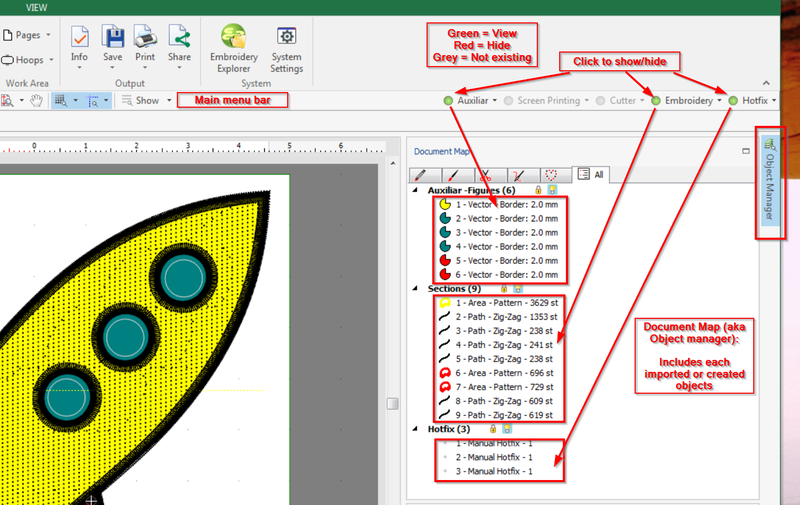
If you are unhappy with the stitching, you can change the parameters of the various stitch sections (see the Stitch Era - adjusting stitch sections tutorial). You also can kill all the Sections and start digitizing again. Warning: Each time you digitize a vector object it will create a new stitch (or hotfix section) and keep the old one !
Remove the stitched rocket windows
As planned, we would like to used hotfix stones instead of embroidery for the windows.
- Untick Auxiliar in the menu bar. Since you need to preserve all the vector drawings for the windows it is better to hide the drawings. This way cannot kill any by mistake !
- Open the Object manager (to the right, see the previous screen capture). You now can see the document map panel to the right.
- Kill the blue window stitch objects
- You also can kill the black circles surrounding the blue window. As you can see by clicking on the black path in the Object Manager, we got two times three borders. One times three borders is enough, unless you do want doubly stitched ones.
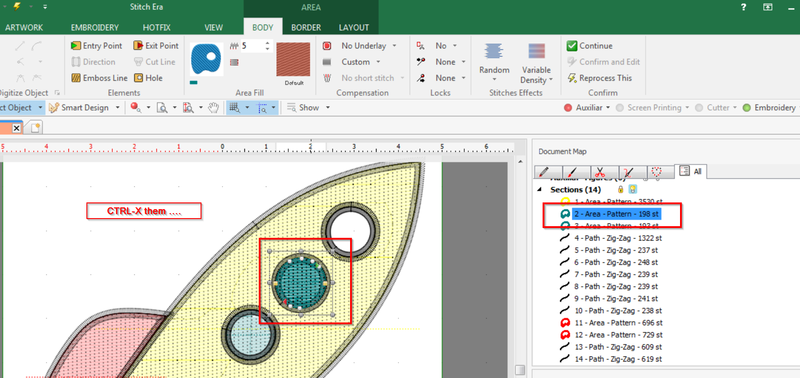
Now, to create the windows, you either you could a single SS34 stone for each window or many tiny ones, e.g. SS6 (2mm).
Option A: Add small hotfix stones
You now can fill the windows of the rocket with a few small hot fix stones. Else if you only need on large stone, jump to the next section.
- Tick Auxiliar and untick Embroidery in the menu bar
- Select the three windows (hold down the CTRL key while you select one by one)
- Open the Hotfix Tab
- Menu Single Hotfix fill -> Areas with Hotfix - Uniform fill
- Untick Auxiliar
- Select the three hofix areas
- Set the stone size and other parameters. The following picture shows SS6 size, 0.6mm distance, and HF Inner Ring Fill pattern. You also could manually add a stone in the middle (see below)
- Tick the embroidery tab to see the result.
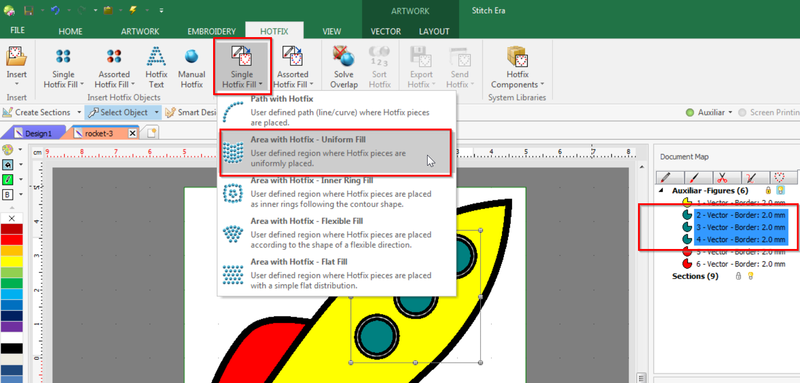
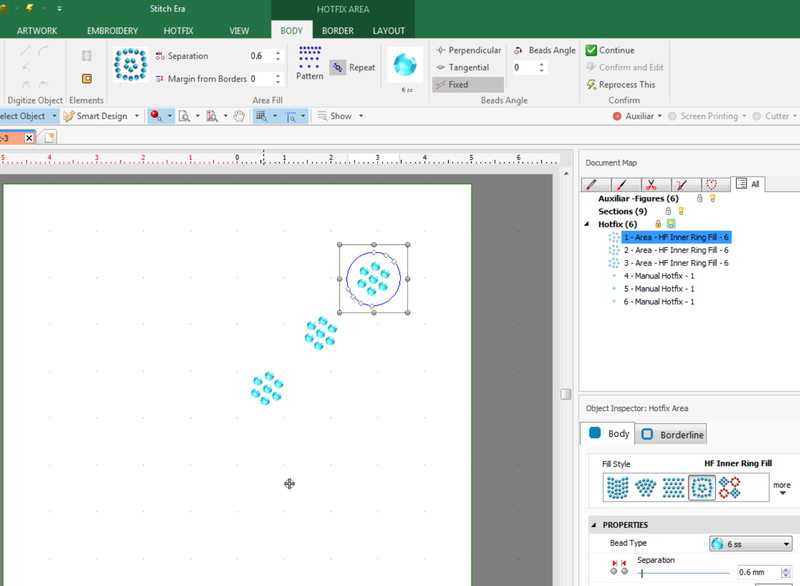

Option B: Add a single stone for each window
Adding individual stones and editing is explained in more detail in the Stitch Era - creating hot fix designs tutorial.
- Untick Auxiliar and Embroidery and tick Hotfix
- Kill all the hotfix areas
- Tick Embroidery
- Hotfix Tab
- Click on Manual
- Now a bit tricky: Open Manual Hotfix / BEAD tab before clicking and select the right stone size. If it is not in the palette, you can add it using "Add bead".
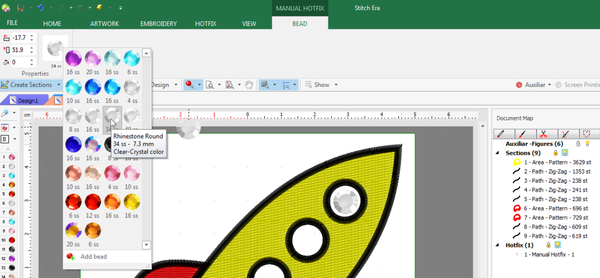
- To fine tune positions of stones, use the Edit Hotfix menu (on top of the stones palette to the left)
- To exit manual setting or edit hotfix, open another tab and click on something.
Read Stitch Era - creating hot fix designs for some more explanation.
A result
The following picture shows an example of my private main use for embroidery: stitch holes in sweaters (pullovers). This one had two moth holes. But I like it simple. The small rockets are 4cm in size, i.e. fit into a small 5x5cm hoop of our Brother PR1050X with some space to manoeuvre. After embroidery, I just put this Merinos wool sweater in the heat press on top of some baking paper. I then added the hotstones manually, put some baking paper on top and then pressed at 200C for 20 seconds.

To improve: The rocket was too small to cover one of the moth holes, so I had to stick a second one over the first one with a result that is frankly not professional. However, the sweater is usable again. Tip: When you design something to cover a moth hole make it rather round and have stitches overlap, i.e. not "empty" spaces. Also make sure that it is at least four times as big as the hole and that you can reposition the embroidery with the control interface (to avoid rehooping if the position is a bit wrong). Instead of taking a practical 5x5cm hoop, consider using a 10x10cm hoop.
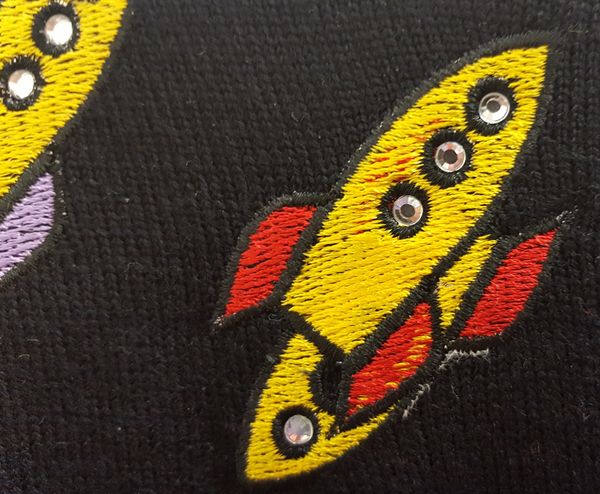
We also might have used some denser fill (right now the yellow, red and violet parts are 5 lines/mm) or put some product on the wool to flatten it down.
Hamburger Example
This example shows how to combine hotfix areas with some embroidery lines. We shall create a hamburger with a little monogram inside.
Import and arrange vector file

The Nounproject is very useful site that includes over a million icons. If you acknowledge the author you are allowed to use any icon for your own use, but you do have to register (it is free). If you pay 40$/year (half for education) you can use these freely and more easily. Of course, I do pay an annual fee since I use these fairly often and since such initiatives should be supported.
- Get file 317585 from the noun project (and register if not already done so). If you cannot do this, you can take it from the picture to the right (click three times on it until you land on the SVG page, then "save it as"), but please understand that you will have to acknowledge the original author.
- Import to Stitch Era: Artwork tab -> Open Vector file
If you do have a noun project membership (40$year/or less) you will see this (otherwise you will have to remove something): A really small hamburger: 9x9.4mm. We want ours at least 10 times as big. We also want to ungroup the elements.
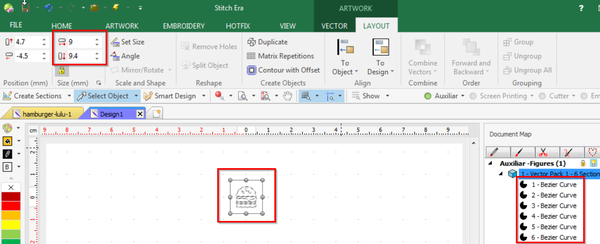
- Now, select all (CTRL-A),
- Artwork -> Layout tab. Enter 90 for the width (left in the ribbon menu)
- Select the object, i.e. click on it
- Ungroup, either in the right-click menu or in Artwork->Layout; Ungroup All button to the right in the ribbon menu
Adjust the view so that you can see all the objects
- CTRL-A
- F6 (or FN-F6) or click the Zoom Area button in the main menu bar
Click on one object. You can see in the ribbon menu that (a) the lines are vectors and (b) that they are not really lines (as in strokes) but fills without borders (strokes). If you like, you can change its color as shown in the following screen capture.
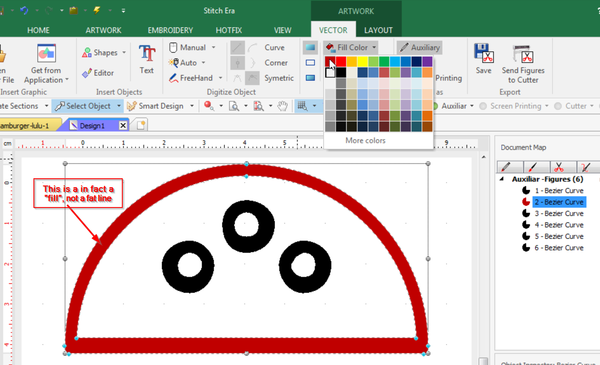
In order to fill these objects with hotfix stones we will have to transform these curves into solid surfaces. There are several ways to do this. In Stitch Era we simply can remove "holes".
- Select all objects
- Make them objects with borders
- Set the thickness to 2.
- Now for each of the six objects: Select each one and click on "Remove holes" in the Layout tab. I suggest opening the object manager on the right and then click on the items in the list one by one.
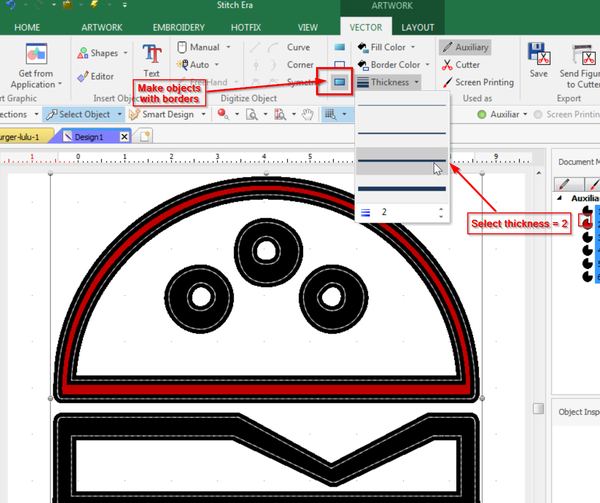

Now we shall subtract the three rounds from the bread on top:
- Select the top "bread" first (this is important), then select the three round "holes"
- Layout tab -> Combine vectors -> subtract.
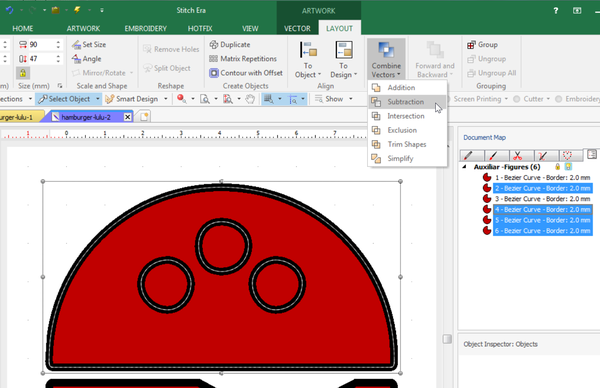
Now we have only three vectors left that we will translate to stitch objects.
Transform the borders into embroidery
- CTRL-A
- Select Embroidery tab
- Art to Stitch -> Art to Stitch (intelligent)
- Select
Fill Borderline Only
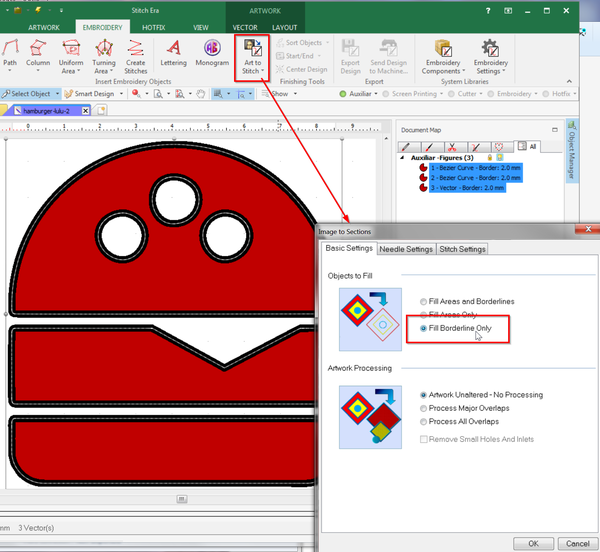
Strangely enough the generated stitches are running stitches. At a thickness of 2, they should be zigzag.
- Open the object manager
- Click on each path (including the ones in the sections pack). In the fill style, select zigzag.
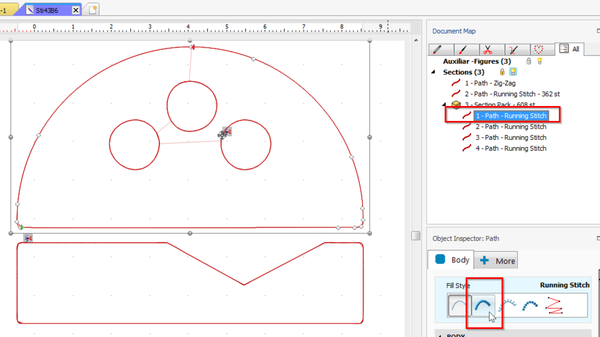
You now got an embroidery:
- Hit F9 and then F7 to see the result.
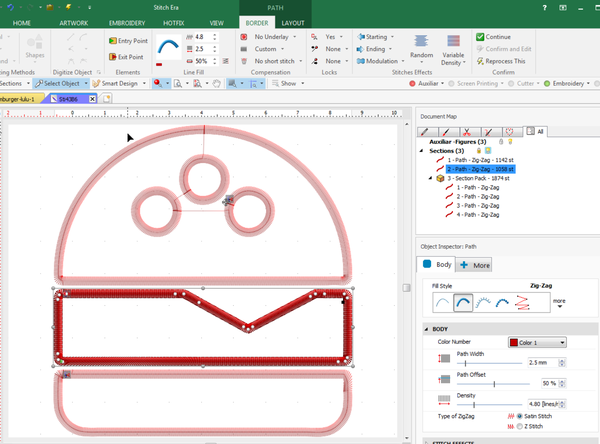
Depending on your taste an textile you now could adjust underlay and density. Otherwise export as embroidery file and give it to your machine.
Transform the fills into hotfix areas
- Hide the embroidery objects (click on the green embroidery button in the main menu bar).
- View the vectors again by clicking on the red Auxiliary buttons.
- Select all: CTRL-A
- Open the hotfix tab
- In the
Single Hotfix Fillmenu (in the middle of the ribbon bar, not to the left !), selectArea with Hotfix - Inner Ring Fill

Now
- Untick Auxiliar
- Tick Hotfix (far right in the main menu bar)
- Hit F9 (if you cannot see the hotfix pattern)
The hotfix looks quite good, but it uses 4ss stones, i.e. really tiny ones that are difficult to handle. We prefer working with 16ss (3mm) for now. Select all, then adjust stone size and other settings. I used:
- SS16
- 1mm separation
Hit F9 (or maybe FN-F9 on your machine) if you cannot see the changes. Also, you could add a simulated background using the little "B" menu on top of the palette to the left of the workspace. Show the embroidery again.
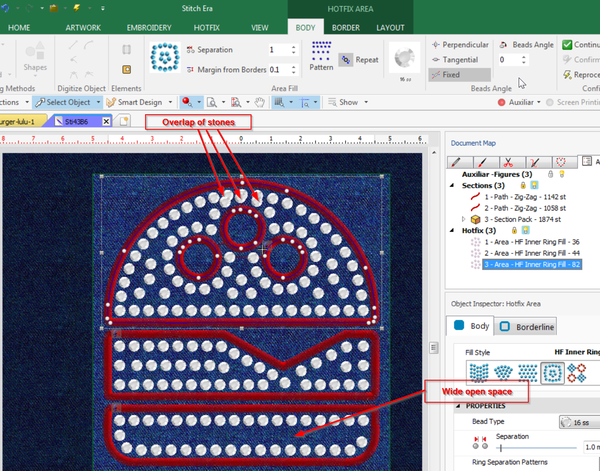
Now you should manually fix two things.
- The lower bread has too much empty space. Consider making it a bit fatter without exiting the hoop space of 10x10cm. We moved the two objects on top upwards a bit to make some space.
- On top there is some overlap, either let Stitch Era fix this or (better) do it yourself. E.g. remove the three offending stones.
Finally, export the hotfix design to SVG (Hotfix tab -> Export Hotfix -> Export Hotfix to file. Select SVG or whatever is suitable for your cutter.
Heat transfer
After I did the first example described above, I got some good transfer paper from an online store and this time the stones stuck very well.
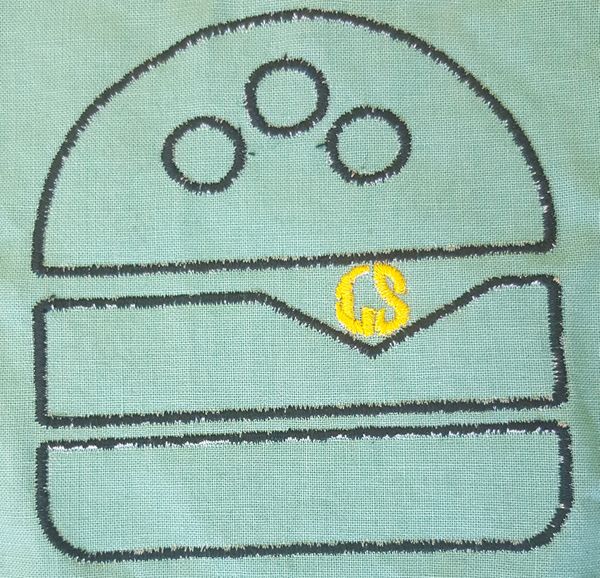
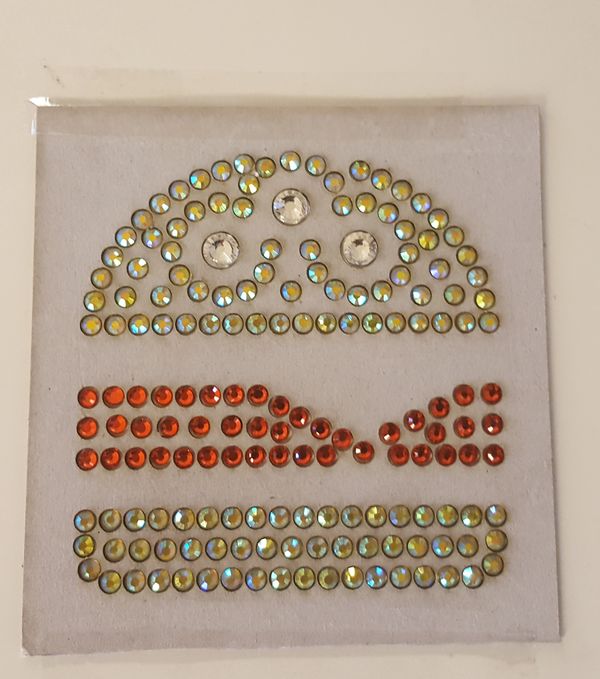
The three large 34SS did not stick after 20 seconds of heating. I then glued them with an applicator
Peeling off the stones from the template went really well. All stones stuck.
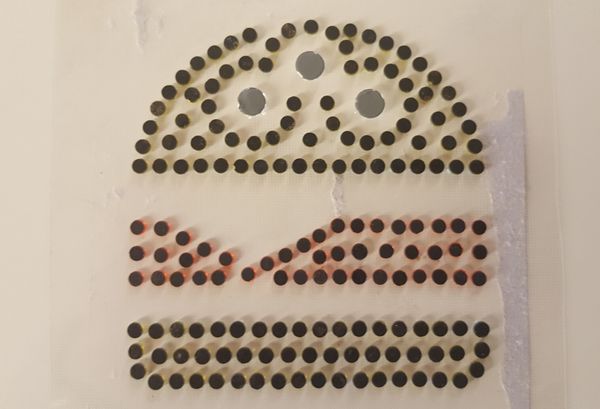
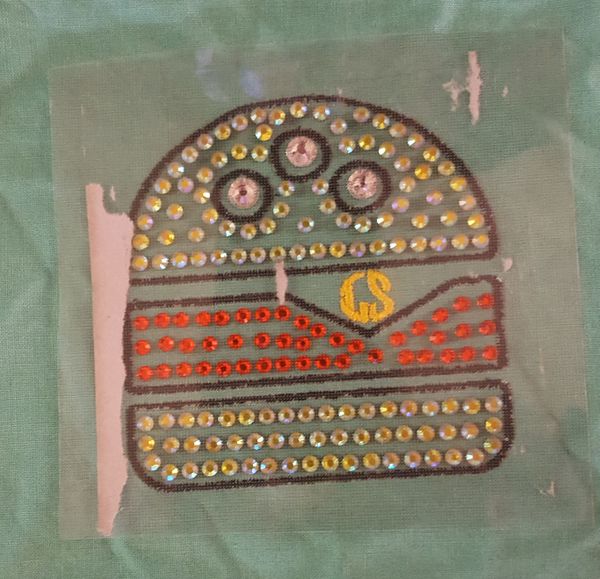
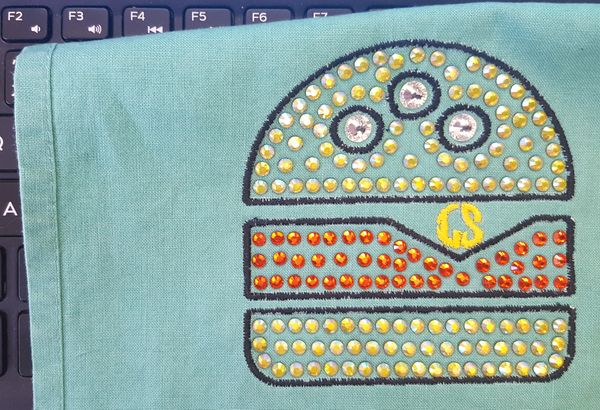
The result was satisfactory for my first "larger" hotstone design and my first use of transfer paper. I should improve the embroidery (zigzags pulled too much into the textile) and probably make a larger design. The monogram is also fairly ugly (too small). I then should try smaller stones.